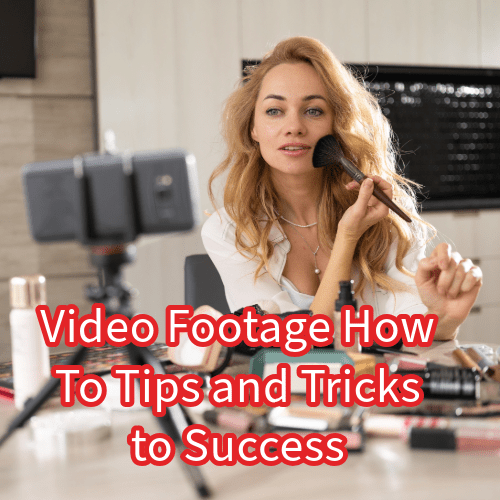
In today’s digital world, video content is king. From social media clips to professional presentations, video footage has become essential for engaging audiences and communicating messages effectively.
Whether you’re a filmmaker, a content creator, or someone looking to improve a video production game, creating high-quality footage requires a combination of technical knowledge, creativity, and the right tools.
Here are some tips and tricks to help you create professional-looking video footage that stands out.
Video Footage – Tips and Tricks to Success

- Planning and Storyboard
One of the most overlooked steps in creating excellent video footage is planning. A well-thought-out plan can make all the difference in your final product, saving you time and helping capture the attention of your target audience.
Start with a storyboard or shot list. Storyboarding helps you visualize the sequence of shots and plan transitions. You don’t have to be an artist; a basic sketch or list of shots will work fine.
If you’re shooting a tutorial or an interview, a shot list might include close-ups, wide shots, and other angles. Planning also includes considering the length and purpose of your video.

Essential questions.
Who is my target audience?
What emotions or actions do I want to inspire?
How much time do I have to tell this story?
Answering these questions will guide your storyboard and ensure each shot contributes to your narrative.
- Tools: Camera and Accessories
The tools you use can significantly impact the quality of your video footage. While high-quality smartphones can produce impressive video, investing in a good camera is beneficial if you’re aiming for more professional footage.
Camera
DSLR and mirrorless cameras are popular choices for their versatility and high-quality output. Consider cameras with 4K resolution, especially if you’re filming for professional purposes.

Lenses
Lenses are crucial in determining the look and feel of your shots. A prime lens (like a 50mm) is great for close-ups, while wide-angle lenses capture more of the surroundings.
Tripods and Stabilizers
A shaky video can make even the best footage look amateurish. Use a tripod to keep the camera steady, or invest in a gimbal stabilizer for smoother handheld shots.
Additional equipment such as an external microphone or lighting setup can also make a significant difference, depending on your environment and sound requirements.
- Lighting
Good lighting separates high-quality videos from average ones. Natural light is great, but not always reliable.
Natural Lighting
If shooting outdoors, early morning or late afternoon (the “golden hours”) are the best hours. Avoid shooting under the midday sun, as it can create harsh shadows.

Artificial Lighting
When shooting indoors, use soft lights to reduce shadows. A common setup is the three-point lighting system (key light, fill light, and backlight), which provides balanced lighting that highlights the subject.
Experiment
Try different lighting angles and intensities to see what works best for your subject. For example, placing a light source behind the subject can create a dramatic silhouette, while front lighting highlights details.
- Frame Your Shots
Framing is an essential aspect of video production that can affect how viewers interpret your footage.
Use these basic composition tips to elevate your shots.

Rule of Thirds
Divide your frame into nine equal parts with two vertical and two horizontal lines. Positioning key elements along these lines or their intersections makes your composition more visually appealing.
Leading Lines
Use lines (like roads, paths, or walls) that lead the viewer’s eye toward the main subject, adding depth to your footage.
Headroom and Look Room
When filming people, give them enough headroom (space above their head) and look room (space in the direction they’re facing). This keeps your shots balanced and natural.
Practicing these framing techniques will improve the professionalism and visual impact of your footage.

- Focus and Exposure
Keeping your subject in focus is critical, and so is maintaining proper exposure.
Focus
For manual focus, zoom in on your subject to adjust focus, then zoom out to frame the shot. This ensures your subject is sharp and clear. Autofocus can work well but can be unreliable, especially if the subject moves.

Exposure
Adjust your camera settings to achieve the right exposure. For a balanced exposure, use the histogram on your camera, which will show you if your shot is overexposed (too bright) or underexposed (too dark).
The goal is to avoid losing details in bright or dark areas.
- Sound: Audio Quality
Good video footage needs good sound. Audio quality can make or break your video, as viewers often tolerate lower video quality but are less forgiving of poor sound.
External Microphone
Built-in microphones on most cameras aren’t ideal for capturing high-quality sound. Use an external microphone to capture clearer audio.

Monitor Sound Levels
Check sound levels while recording to avoid clipping, which results in distorted audio. Use headphones to monitor audio in real time.
Control Background Noise
Find a quiet place to shoot and eliminate unwanted sounds. If you’re filming outside, consider using a windscreen on your microphone.
- Camera Settings
Familiarize yourself with your camera settings to improve the quality of your footage.
Frame Rate
Common frame rates include 24 fps (cinematic feel) and 30 fps (standard for most online videos). Higher frame rates, like 60 fps, are ideal for slow-motion shots.

Resolution
While 1080p is standard, 4K is becoming more popular for its clarity. Choose the best resolution your camera offers, especially for professional projects.
White Balance
Set the white balance according to the lighting conditions to avoid color shifts in your footage. Most cameras have presets (daylight, tungsten, etc.) that help you adjust.
- Editing
Editing helps improve your footage and lets you add creative touches.
Use Professional Software
Programs like Adobe Premiere Pro, Final Cut Pro, or DaVinci Resolve offer powerful editing tools. If you’re a beginner, software like iMovie or Filmora works well.

Cut Unnecessary Footage
Trim your footage to keep your video concise and engaging. Cut out any unnecessary scenes to maintain flow and rhythm.
Add Transitions and Effects
Use transitions sparingly to keep the viewer focused. Overuse of effects can look unprofessional, so apply them with purpose.
- Color Grading and Corrections
Color grading enhances your video’s visual appeal. While color correction ensures accurate colors, color grading gives your footage a specific look or mood.
Correct White Balance and Exposure
Adjust these before you start grading. Basic color correction includes balancing shadows and highlights to ensure the footage looks natural.

Experiment with Color Grading
You can add a cinematic look, a vintage feel, or make colors pop. Tools like LUTs (Look-Up Tables) simplify grading but don’t rely solely on them.
- Practice and Continuous Learning
Creating high-quality video footage requires practice. Experiment with different shots, techniques, and equipment.
Don’t be afraid to try new approaches or make mistakes; each experience will improve your skills.

Continuous Learning
The video production landscape is always evolving, with new techniques and tools emerging regularly. Join online communities, watch tutorials, and practice regularly to stay up-to-date.
Creating successful video footage is a blend of planning, technique, and creativity. By following these tips and tricks, you can create professional-quality videos that captivate and engage your audience.
These tips and tricks can help create compelling videos, improve your video footage, and drive success.
AI Tools for You
https://www.bestprofitsonline.com/myblog/newai
Tip
How To Improve Your Social Media Marketing
